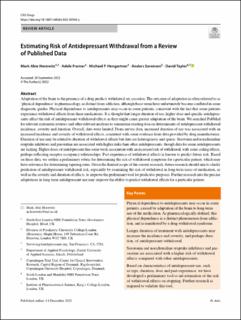Please use this identifier to cite or link to this item:
https://doi.org/10.21256/zhaw-26458Full metadata record
| DC Field | Value | Language |
|---|---|---|
| dc.contributor.author | Horowitz, Mark Abie | - |
| dc.contributor.author | Framer, Adele | - |
| dc.contributor.author | Hengartner, Michael P. | - |
| dc.contributor.author | Sørensen, Anders | - |
| dc.contributor.author | Taylor, David | - |
| dc.date.accessioned | 2022-12-16T14:20:00Z | - |
| dc.date.available | 2022-12-16T14:20:00Z | - |
| dc.date.issued | 2022-12-14 | - |
| dc.identifier.issn | 1172-7047 | de_CH |
| dc.identifier.issn | 1179-1934 | de_CH |
| dc.identifier.uri | https://digitalcollection.zhaw.ch/handle/11475/26458 | - |
| dc.description.abstract | Adaptation of the brain to the presence of a drug predicts withdrawal on cessation. The outcome of adaptation is often referred to as 'physical dependence' in pharmacology, as distinct from addiction, although these terms have unfortunately become conflated in some diagnostic guides. Physical dependence to antidepressants may occur in some patients, consistent with the fact that some patients experience withdrawal effects from these medications. It is thought that longer duration of use, higher dose and specific antidepressants affect the risk of antidepressant withdrawal effects as they might cause greater adaptation of the brain. We searched PubMed for relevant systematic reviews and other relevant analyses to summarise existing data on determinants of antidepressant withdrawal incidence, severity and duration. Overall, data were limited. From survey data, increased duration of use was associated with an increased incidence and severity of withdrawal effects, consistent with some evidence from data provided by drug manufacturers. Duration of use may be related to duration of withdrawal effects but data are heterogenous and sparse. Serotonin and noradrenaline reuptake inhibitors and paroxetine are associated with higher risks than other antidepressants, though data for some antidepressants are lacking. Higher doses of antidepressant has some weak association with an increased risk of withdrawal, with some ceiling effects, perhaps reflecting receptor occupancy relationships. Past experience of withdrawal effects is known to predict future risk. Based on these data, we outline a preliminary rubric for determining the risk of withdrawal symptoms for a particular patient, which may have relevance for determining tapering rates. Given the limited scope of the current research, future research should aim to clarify prediction of antidepressant withdrawal risk, especially by examining the risk of withdrawal in long-term users of medication, as well as the severity and duration of effects, to improve the preliminary tool for predictive purposes. Further research into the precise adaptations in long-term antidepressant use may improve the ability to predict withdrawal effects for a particular patient. | de_CH |
| dc.language.iso | en | de_CH |
| dc.publisher | Springer | de_CH |
| dc.relation.ispartof | CNS Drugs | de_CH |
| dc.rights | http://creativecommons.org/licenses/by-nc/4.0/ | de_CH |
| dc.subject.ddc | 615: Pharmakologie und Therapeutik | de_CH |
| dc.subject.ddc | 616.8: Neurologie und Krankheiten des Nervensystems | de_CH |
| dc.title | Estimating risk of antidepressant withdrawal from a review of published data | de_CH |
| dc.type | Beitrag in wissenschaftlicher Zeitschrift | de_CH |
| dcterms.type | Text | de_CH |
| zhaw.departement | Angewandte Psychologie | de_CH |
| zhaw.organisationalunit | Psychologisches Institut (PI) | de_CH |
| dc.identifier.doi | 10.1007/s40263-022-00960-y | de_CH |
| dc.identifier.doi | 10.21256/zhaw-26458 | - |
| dc.identifier.pmid | 36513909 | de_CH |
| zhaw.funding.eu | No | de_CH |
| zhaw.issue | 2 | de_CH |
| zhaw.originated.zhaw | Yes | de_CH |
| zhaw.pages.end | 157 | de_CH |
| zhaw.pages.start | 143 | de_CH |
| zhaw.publication.status | publishedVersion | de_CH |
| zhaw.volume | 37 | de_CH |
| zhaw.publication.review | Peer review (Publikation) | de_CH |
| zhaw.webfeed | Klinische Psychologie | de_CH |
| zhaw.funding.zhaw | Antidepressiva Entzug bei Hausarzt-PatientInnen | de_CH |
| zhaw.author.additional | No | de_CH |
| zhaw.display.portrait | Yes | de_CH |
| Appears in collections: | Publikationen Angewandte Psychologie | |
Files in This Item:
| File | Description | Size | Format | |
|---|---|---|---|---|
| 2022_Horowitz-etal_Estimating-risk-of-antidepressant-withdrawal.pdf | 992.4 kB | Adobe PDF |  View/Open |
Show simple item record
Horowitz, M. A., Framer, A., Hengartner, M. P., Sørensen, A., & Taylor, D. (2022). Estimating risk of antidepressant withdrawal from a review of published data. CNS Drugs, 37(2), 143–157. https://doi.org/10.1007/s40263-022-00960-y
Horowitz, M.A. et al. (2022) ‘Estimating risk of antidepressant withdrawal from a review of published data’, CNS Drugs, 37(2), pp. 143–157. Available at: https://doi.org/10.1007/s40263-022-00960-y.
M. A. Horowitz, A. Framer, M. P. Hengartner, A. Sørensen, and D. Taylor, “Estimating risk of antidepressant withdrawal from a review of published data,” CNS Drugs, vol. 37, no. 2, pp. 143–157, Dec. 2022, doi: 10.1007/s40263-022-00960-y.
HOROWITZ, Mark Abie, Adele FRAMER, Michael P. HENGARTNER, Anders SØRENSEN und David TAYLOR, 2022. Estimating risk of antidepressant withdrawal from a review of published data. CNS Drugs. 14 Dezember 2022. Bd. 37, Nr. 2, S. 143–157. DOI 10.1007/s40263-022-00960-y
Horowitz, Mark Abie, Adele Framer, Michael P. Hengartner, Anders Sørensen, and David Taylor. 2022. “Estimating Risk of Antidepressant Withdrawal from a Review of Published Data.” CNS Drugs 37 (2): 143–57. https://doi.org/10.1007/s40263-022-00960-y.
Horowitz, Mark Abie, et al. “Estimating Risk of Antidepressant Withdrawal from a Review of Published Data.” CNS Drugs, vol. 37, no. 2, Dec. 2022, pp. 143–57, https://doi.org/10.1007/s40263-022-00960-y.
Items in DSpace are protected by copyright, with all rights reserved, unless otherwise indicated.